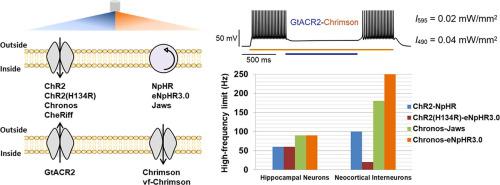Neuroscience ( IF 2.9 ) Pub Date : 2020-09-15 , DOI: 10.1016/j.neuroscience.2020.09.022 Himanshu Bansal 1 , Neha Gupta 1 , Sukhdev Roy 1

|
Low-power and high-frequency bidirectional control of spatiotemporal patterns of neural spiking is one of the major challenges in optogenetics. A detailed theoretical analysis and optimization with ChR2-NpHR, ChR2(H134R)-eNpHR3.0, Chrimson-GtACR2 and also with prospective opsin pairs namely, Chronos-Jaws, Chronos-eNpHR3.0, CheRiff-Jaws and vf-Chrimson-GtACR2 has been presented. Biophysical circuit models of bidirectional optogenetic control in above opsin pairs expressing hippocampal neurons and fast-spiking neocortical interneurons have been formulated. The models include the important rebound effect of chloride ions and overlapping of absorption spectra. Blue light absorption by red-shifted opsins not only affects the photocurrent, but also its turn-off kinetics. Under continuous illumination, bidirectional control of spiking around 40 Hz in hippocampal neurons requires very low blue and orange light intensities of 0.014 mW/mm2 and 0.8 mW/mm2 with CheRiff-Jaws and 0.04 mW/mm2, and 0.02 mW/mm2 with Chrimson-GtACR2, respectively. Under optimal photostimulation and expression density, high-frequency limit of bidirectional control is 60 Hz and 100 Hz with ChR2-NpHR, 60 Hz and 20 Hz with ChR2(H134R)-eNpHR3.0, 90 Hz and 180 Hz with Chronos-Jaws, and 90 Hz and 250 Hz with Chronos-eNpHR3.0 in neurons and interneurons, respectively. Although, Chrimson-GtACR2 enables bidirectional control at very low-power, vf-Chrimson-GtACR2 provides control with reduced cross-talk. The theoretical analysis highlights the usefulness of computational methods to virtually optimize stimulation protocols for optogenetic tool combinations. The study is useful to generate neural codes with desired spatiotemporal resolution and to design optogenetic neuroprosthetic devices and circuits.
中文翻译:

单尖峰分辨率的高频神经码低功率双向光遗传控制的理论分析。
神经峰值的时空模式的低功率和高频双向控制是光遗传学的主要挑战之一。使用ChR2-NpHR,ChR2(H134R)-eNpHR3.0,Chrimson-GtACR2以及预期的视蛋白对(Chronos-Jaws,Chronos-eNpHR3.0,CheRiff-Jaws和vf-Chrimson-GtACR2)进行详细的理论分析和优化已经提出。已经建立了以上表达海马神经元和快速掺入的新皮层神经元的视蛋白对的双向光遗传学控制的生物物理电路模型。该模型包括氯离子的重要回弹效应和吸收光谱的重叠。红移视蛋白吸收蓝光不仅影响光电流,而且还影响其关闭动力学。在连续照明下2和0.8毫瓦/毫米2与CheRiff封钳和0.04毫瓦/毫米2,和0.02毫瓦/毫米2分别使用Chrimson-GtACR2。在最佳光刺激和表达密度下,使用ChR2-NpHR时双向控制的高频极限为60 Hz和100 Hz,使用ChR2(H134R)-eNpHR3.0时双向控制的高频极限为60 Hz和20 Hz,使用Chronos-Jaws时为90 Hz和180 Hz, Chronos-eNpHR3.0在神经元和中间神经元中分别为90 Hz和250 Hz。尽管Chrimson-GtACR2能够以非常低的功率进行双向控制,但vf-Chrimson-GtACR2却能提供降低串扰的控制。理论分析强调了计算方法实际上可以优化光遗传学工具组合的刺激方案的有用性。该研究对于产生具有所需时空分辨率的神经代码以及设计光遗传学的神经修复装置和电路很有用。











































 京公网安备 11010802027423号
京公网安备 11010802027423号